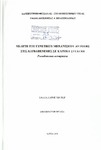Μελέτη του γενετικού μηχανισμού αντοχής στις καρβαπενέμες σε κλινικά στελέχη Pseudomonas aeruginosa

Öffnen
Autor
Σακελλάρης, ΒίκτωρSupervisor name
Μόσιαλος, Δημήτρης
Datum
2010Language
el
Access
free
Zusammenfassung
Pseudomonas aeruginosa is one of the most common gram-negative hospitalacquired
pathogens. This organism shows a remarkable resistance to antibiotics, mostly
because of acquisition of resistance genes e.g., genes for beta-lactamases, combined with
over-expression of efflux pumps and/or decreased expression of porins. The most
common beta-lactamases are IMP and VIM type MBL, as well as OXA-ESBLS and give
to the bacteria high resistance to b-lactam antibiotics, especially carbapenems. The genes
for VIM and IMP enzymes, like those for OXA-ESBLs, are transferable as most are
found as gene cassettes located primarily on integrons, sometimes within transposons or
on plasmids, a condition that provides a wide potential for expression and dissemination
in gram-negative pathogens. Since the first finding of IMP] metallo-B-lactamase in a
clinical isolate of Pseudomonas aeruginosa in Japan in 1988, IMP-type enzymes are
spread worldwide, increasing in two decades the proportion of P. aeruginosa isolates
demonstrating resistance to imipenem, due to IMPmbls? from 13% to 20%. Currently have
indentified 26 carbapenem-hydrolyzing enzymes of the IMP-type.
In this study we present the discovery of a new IMP type MBL from 6 P.
aeruginosa clinical strains. This novel IMP-type MBL is highly divergent from IMPi,
possessing 44 different amino acids, whereas the most divergent till now IMP-type MBL,
IMP12, has only 36 different amino acids from IMP]. This new IMP-MBLs was found in
a class 1 integron next to ΟΧʼ35 gene. The next objective will be the biochemical
characterization of this new IMP metallo-fl-lactamase.
Academic publisher
Πανεπιστήμιο Θεσσαλίας. Σχολή Επιστημών Υγείας. Τμήμα Βιοχημείας και Βιοτεχνολογίας.
